When it comes to clean beauty, people have so many misconceptions. Some believe it’s too bougie or ineffective, when in reality that’s just not the case. So then what exactly is it? Why is it important? Well, there’s not one definitive definition for clean beauty, yet there is the widely accepted description that it’s made of non-toxic ingredients. When you really think about it, do you have any idea what ingredients make up your favorite lip gloss, foundation, concealer… (the list goes on)? If I’m going to be honest, you may not even want to know. Thankfully, this trend of clean beauty is becoming more and more popular and brands are making a conscious effort to hop on the clean train and leave their unregulated past behind. With that being said, the American government has not regulated the personal care industry since 1938, which is ABSURD. This gives companies the freedom to put whatever they choose in their products despite how bad the ingredients may be for one’s health. The government doesn’t require any studies or pre-market testing of chemicals for these products. Now, you may be thinking things like, “what about the products that are labeled natural or green?”, “what’s the difference between those products and clean beauty products?” Since this industry is self-regulating, companies are capable of putting these labels on their products without oversight (which is really scary and concerning). This action is called “greenwashing” and it’s a trap you do not want to fall into… So now what? This doesn’t mean you should throw out all of your makeup/ personal care products. Instead, you should look more into the future products you plan on purchasing.
-
The first step is research. You should be able to recognize harmful ingredients in products and understand what they can do to your health. Some ingredients you should look out for are: Parabens (which are linked to reproductive organ harm, thyroid disruption, hormone disruption, etc.), Phthalates (which are linked to hormonal and reproductive harm, and carcinogen which causes cancer), and hydroquinone (which is linked to certain cancers, decreased immune responses, etc.). There are many more ingredients to avoid which could be found on websites like EWG.com or by a simple google search. Everyone’s favorite TV personality, Jonathan Van Ness has a segment on the Biossance youtube channel where he discusses clean beauty in an exciting way.
-
The next step is to look into the basics. These you can find on websites like Credobeauty.com, follain.com, or even sephora.com (under clean beauty). When looking for basics start out with foundation, concealer, and mascara. The Kosas tinted face oil gives you solid lightweight coverage without the harmful ingredients. The RMS Beauty uncover up concealer is a great product for the imperfections you want to diminish. Lastly, the Llia limitless lash mascara does WONDERS without making your lashes clunky.
-
The final step is to get involved! Look into the work that the Environmental Working Group (EWG) is doing for beauty reform and advocate for cleaner and better products. EWG has also created an app called Healthy Living which allows you to scan products and see whether or not they are good for you based on their scale.



